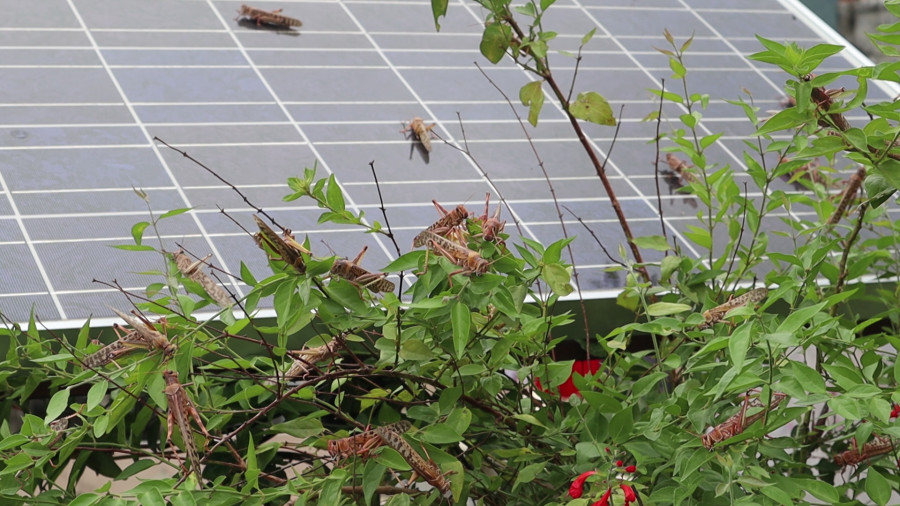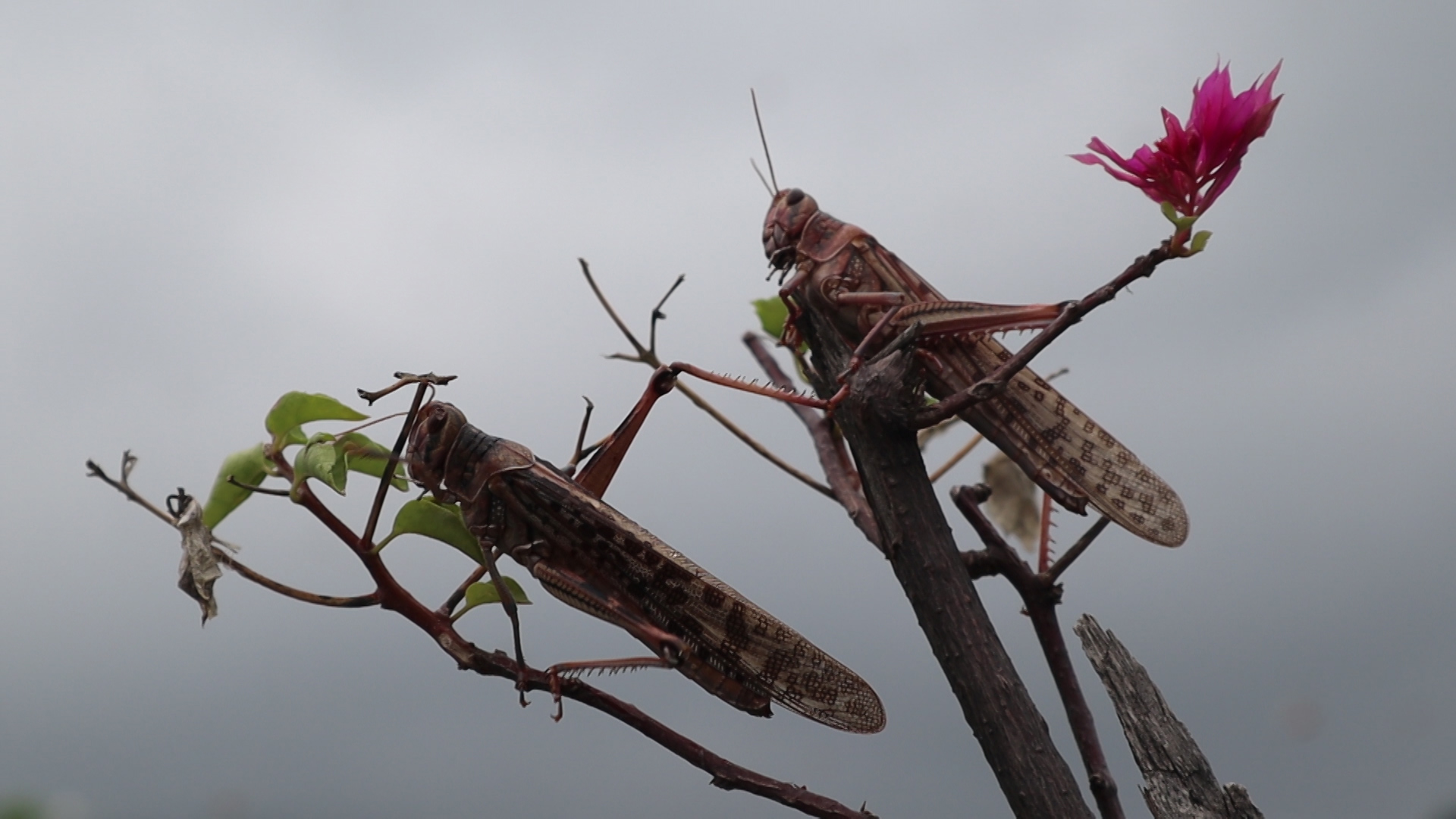National
After fall armyworm havoc and Covid-19, locust invasion is new threat to food security
Massive invasions like those in Pakistan and African countries could spell catastrophe for Nepal where food production is already low, experts say.
Chandan Kumar Mandal & Sangam Prasain
On Saturday morning, when Santosh Budhathoki of Sindhuli walked up to his corn field, he saw some strange bugs flying around. The number started to grow–and it was soon in the thousands. For farmers like Budhathoki who recently had to bear the brunt of American fall armyworm that destroyed their crops, swarms of this new pest hovering over their plants set off an alarm.
“We don’t know how to get rid of this insect,” said Budhathoki. “We are extremely worried.”
Government officials later confirmed that the invading species was a desert locust, which in huge numbers had made their way into Nepal.
Later in the noon, swarms of locusts were also sighted in various other districts like Rupandehi, Palpa, Bara, Sarlahi and Parsa.
Saturday’s sightings mark a fresh entry of the grasshoppers, which can ravage crops and jeopardise food security, after more than two decades.
Madhukar Upadhya, a watershed practitioner and climate change expert, said the small group of locusts might have entered Nepal for breeding purposes.
“This incident can be a precursor to an impending massive invasion the next season, for which the country is not prepared well. This can hugely affect the country's food security,” Upadhya told the Post.
According to the Food and Agriculture Organization (FAO) of the United Nations, the desert locust (Schistocerca gregaria) is considered the most dangerous of all migratory pest species in the world. It threatens people’s livelihoods, food security, the environment and economic development. The grasshoppers can reproduce rapidly, migrate long distances, devastate crops and pastures and can easily affect more than 65 of the world’s poorest countries.
The FAO report says that the desert locust has the ability to change its behavior and appearance, under particular environmental conditions (unusually heavy rains), and transform itself from a harmless individual to part of a collective mass of insects that form a swarm, which can cross continents and seas, and quickly destroy a farmer’s field and his entire livelihood in a single morning.
The entry of locust swarms into the country is the latest of the three threats—after fall armyworm and the Covid-19 pandemic—to Nepal’s food security. Food insecurity has been compounded by virus containment measures such as lockdown, which has disrupted production and supply chains.
Nepal has reported 12,309 coronavirus cases with 28 deaths as of Saturday.
Government officials could not immediately confirm the number of insects that could have entered Nepal, possibly from the Indian state of Bihar. Earlier on Saturday, Gurugram areas of Haryana in India also witnessed swarms of locusts that spread over two kilometres.
Upadhya said the entry of locusts raises an alarm bell and if they start entering in millions, controlling them could be extremely difficult.
“Before entering Nepal, they must have been sighted in India and we failed to monitor their movement,” said Upadhya.
Experts say the movement of the swarms will depend on the direction of the wind.

In Nepal, the wind has been blowing west to the north for the last two days, said Hari Bahadur KC, spokesperson for the Ministry of Agriculture and Livestock Development.
Sahadev Prasad Humagain, chief of the Plant Quarantine and Pesticide Management Centre under the Ministry of Agriculture, said the locusts that were sighted on Saturday were scattered groups.
“But their arrival is likely to continue for a couple of days with the current weather conditions,” said Humagain. “Therefore, we have to be careful and step up measures to minimise the damage to agriculture farms and crops.”
Some experts believe that since it's a paddy plantation season in Nepal and fields are mostly covered with water due to monsoon rainfall, the insect may not be able to destroy food crops.
But there are chances that vegetable crops could be affected if they start arriving in swarms.
According to reports, the swarms are massive with tens of billions of flying bugs, ranging anywhere from a third of a square mile to 100 square miles or more, with 40 million to 80 million locusts packed in half a square mile. They bulldoze pasturelands in dark clouds the size of football fields and small cities. In northern Kenya, one swarm was reported to be 25 miles long by 37 miles wide—it would blanket the city of Paris 24 times over.
According to the FAO, an adult desert locust can consume roughly its own weight in fresh food per day that is about two grams every day.
“A one square-kilometer size swarm contains about 40 million locusts, which eat the same amount of food in one day as about 35,000 people, 20 camels or 6 elephants,” says the FAO.
After reports of millions of hectares of land under attack by billions of locusts in Africa, China, Pakistan, and India, the government had formed a five-member task force in late May to study the possibility of their arrival in Nepal. However, a preliminary study by the task force had said that locusts are unlikely to invade Nepal.
Humagain of the Plant Quarantine and Pesticide Management Centre said within hours of sighting of the new insects, they had mobilised technicians from different agriculture knowledge centres, formerly district agriculture offices, in the districts.
After sudden sightings of locusts were reported in different districts, the Agriculture Ministry called an emergency meeting, inviting government officials and experts from all seven provinces, and asked them to be on high alert.
Upadhya, however, said leaving the locust problem to poorly resourced agriculture knowledge centres will only exacerbate the situation.
“We have seen how government agencies failed to effectively respond to the fall armyworm problem,” said Upadhya. “It will be wrong to consider the locust invasion a farmers’ problem; it is an issue that concerns the whole country.”
If locusts start ravaging crops amid this Covid-19 pandemic, Nepal will be in for a massive food insecurity, according to Upadhya.
According to the Agriculture Ministry, Nepal had experienced its first locust attack in 1962. However, the worst locust attack was observed in 1996 when swarm incursions destroyed 80 percent of crops in Chitwan and partially damaged crops in Makwanpur, Mahottari and Bara districts.
“Massive invasions like those in Pakistan and African countries will mean a catastrophe for Nepal where food production is low,” said Upadhya. “Soon we won’t have enough remittance to import [food] from outside. More than rural areas, it can cause problems for urban centres.”
Raj Kumar Karki from Sindhuli contributed reporting.




 7.12°C Kathmandu
7.12°C Kathmandu
















